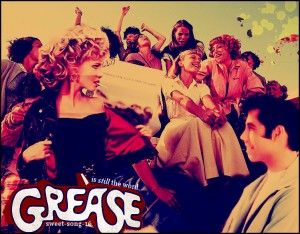Grease Lightnin’
As a child, Grease was one of my most watched movie, mostly because it was one my grandma’s favorites, so I’d see it every time I went over to her house. The film was produced by Paramount Pictures and released in 1978. A PG13 film due to sexual content and references, teen smoking, and drinking, Grease exemplified many of the fears that were present in the delinquency and rebellion of the generation of adolescents. The film, although released in the late 70s is set in 50s America, traces the lives of a couple rebellious high school seniors, the T-Bird boys and the Pink Lady girls. Throughout the movie, the T-Bird boys are seen pushing their masculine and rebellious role, spending their time working in the school auto shop, chasing girls, and causing trouble along the way. The Pink Lady girls, on the other hand, are shying away from some of the more typically female characteristics, within the realm of maintaining their womanhood.

In the back, Sandra D sits in the pink skirt, before her rebellion; in the front, smoking, is the new Sandra D after the influences of modern pop culture have influenced her. Created by a Grease fan at fanpop.com
Most notably, Rizzo spends her time trying to act like one of the guys; chasing guys instead of letting them chase her, and promoting the “sexualization” of the teenager through her actions and dress. By the end, Rizzo has not only exemplified a change in the meaning of womanhood, but she has also transformed good-girl Sandra D into a rebellious girl like herself. The growing movement of female gender roles expresses the clear change that was occurring in the 50s. Parents were no longer able to restrict the pop culture of the generation’s adolescents. In addition to the importance of changing gender roles, the film expresses some clear moral panics of the ages through the story. The rebellious girls are able to take in Sandra D and transform her from a feminine ideal girl to a rebellious, sex-driven teenager, which exemplifies the fears of the previous generation of parents. Even the most feminine and traditional of girls could lose their way in modern pop culture. The film clearly shows the moral panics of the previous generation of parents and the ever changing gender roles of the newer generation in the 1950s.

Loved this post! It really made me think. I don’t bevliee that I’ve ever (at least in recent days) danced the way you’ve described here. I want to try it! I think I might just turn up the volume on my stereo in the living room and just dance! All by myself, just for the heck of it. Can’t wait! Thank you for sharing this.